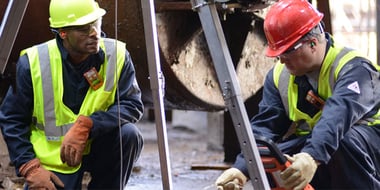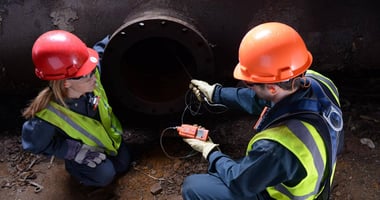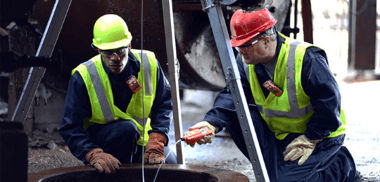We have all heard the famous line from the 1967 movie Cool Hand Luke: “What we’ve got here is failure to communicate.” Poor communication can lead to unexpected and unwanted outcomes in many situations, but lack of communication or “failure to communicate” during a confined space entry can lead to tragedy.
I don’t know of anyone who really enjoys entering a confined space – an area with a limited path to enter and exit, not designed to be occupied by a human, yet big enough for someone to go in to do a needed job. I have been in many, dating back well before my actual 35 years in the business, and I can’t think of anything much worse than crawling into a dark hole without knowing for certain that someone on the outside had my back and was watching over me. Trust me, I’ve been there more than once.
 Confined space communication begins well before anyone actually breaks the plane to enter the space itself. It starts with proper understanding of the hazards and risks that someone may encounter when working inside the space. The National Fire Protection Agency NFPA 350 Guide to Safe Confined Space Entry and Work says that communication is a “vital, reiterative part of reducing hazards” in confined space entries.
Confined space communication begins well before anyone actually breaks the plane to enter the space itself. It starts with proper understanding of the hazards and risks that someone may encounter when working inside the space. The National Fire Protection Agency NFPA 350 Guide to Safe Confined Space Entry and Work says that communication is a “vital, reiterative part of reducing hazards” in confined space entries.
Hazards are identified and communicated during job hazard assessments and can also be communicated through other resources such as Safety Data Sheets (SDS) that identify substances that might be found inside a space, blueprints and schematics that communicate information about the construction and equipment that may be in the space, and posted placards and markings that provide entrants with specific warnings about the space. You had better be paying attention to these things before you go inside the space so you know exactly what you may be in for.
Meeting Hazard Communication Standards
Hazard communication is just the beginning of the communication requirements in confined spaces. The United States Federal Register final rule for Confined Spaces in Construction, 1926.1208(d)(3), which is for all intents and purposes identical to the final rule for confined space entry in general industry 1910.146(d)(4)(iii), says that an attendant on a confined space entry must have all the equipment necessary to communicate effectively with the entrants in the space. That attendant must also have the ability to summon help in an emergency if required and inform the entrants if anything outside the space creates a threat to them working safely inside.
Communication with entrants in a confined space can come in a variety of forms, including:
- Direct voice-to-voice communication between the attendant and the entrant(s)
- Two-way radios
- Other methods of non-verbal or visual communication.
But what happens if the configuration of the space is complex and the attendant can’t see the entrants? What if the work in the space creates too much noise, making it difficult to hear the attendant or the radio while wearing hearing protection? What if wearing a respirator muffles the entrant’s voice, making a call for help difficult to understand? What if the configuration of the space limits two-way radio reception? What if…?
Simplifying Communication with Portable Gas Detectors
Permit required confined space entries require a portable gas detector to test the atmosphere inside the space prior to anyone entering it. Many would suggest that the requirement should apply to all confined spaces. NFPA 350 Sec. 7.13.1 goes even a bit further saying that the “atmosphere within and outside the confined space should be monitored continuously to ensure continued safe working conditions.”
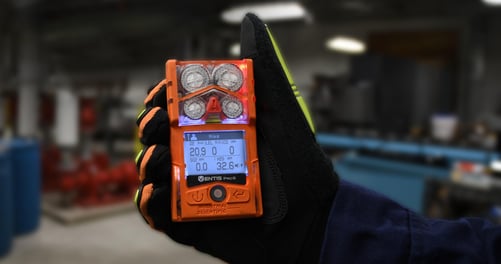 The most effective way to accomplish this is for each entrant in the space to carry a portable, personal multi-gas detector such as the Ventis® Pro5. Personal gas monitors are available today with embedded radio systems that can provide communication from inside confined spaces to the world outside. These systems allow the detectors to easily form wireless mesh communication networks that repeat messages and allow for continuous transmission of radio signals from within even the most difficult confined spaces. The gas detectors transmit sensor readings continuously, allowing an attendant outside the space to see conditions inside on a detector monitoring the entry point or on a separate monitoring console.
The most effective way to accomplish this is for each entrant in the space to carry a portable, personal multi-gas detector such as the Ventis® Pro5. Personal gas monitors are available today with embedded radio systems that can provide communication from inside confined spaces to the world outside. These systems allow the detectors to easily form wireless mesh communication networks that repeat messages and allow for continuous transmission of radio signals from within even the most difficult confined spaces. The gas detectors transmit sensor readings continuously, allowing an attendant outside the space to see conditions inside on a detector monitoring the entry point or on a separate monitoring console.
Conditions can also be monitored remotely or from multiple spaces at the same time with iNet® Now Live Monitoring software. Monitor-to-monitor communication lets an entrant in the space know if a co-entrant has encountered a gas hazard or is experiencing a physical or medical emergency at the same time the attendant is alerted outside.
In the same manner, that attendant can use the gas detector to alert workers inside the space if conditions outside are going to compromise their safety. The radio messages from these devices will even allow the gas detector systems themselves to alert first responders and rescue personnel if necessary, providing them with more direct information about the nature of the emergency and the exact location of the space.
Good communication shouldn’t stop when the entry operations are over. Information recorded and collected from gas monitors that continuously monitor confined spaces should be stored and reviewed with the iNet Control platform, and used to inform teams of the conditions encountered during an entry and prior to the next entry into the same confined space. This provides ample opportunity to mitigate unexpected hazardous conditions before they are encountered again.
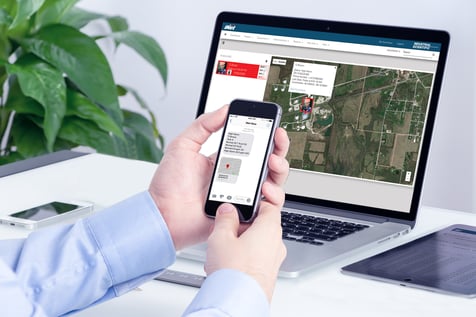
If confined space entry operations are going be performed safely, you simply can’t tolerate a “failure to communicate.” The next time you send your team to enter a confined space, make sure they are have all the right information and are carrying the right gas detection equipment that will not only save their lives but also let them know that someone always has their back.
